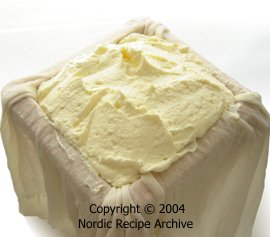
|
|||
| MAIN RECIPE PAGE |
|
||
|
RUSSIAN EASTER PASKHA
Note that Finnish eggs are among the safest in the world to be eaten uncooked. To find out why, read here.
There are many variations to this basic paskha recipe, some of them adding various extra flavourings in the mixture, like chopped almonds or nuts, raisins, fresh, canned or candied fruit, cocoa, chocolate etc. However, recipes like those are deeply frowned upon by all Finnish families with old Russian and Orthodox heritage, like mine. Mixed in the dish, the pieces of fruit and nuts feel like pebbles, and the bloated raisins like unpleasant, slimy lumps, ruining the smooth, creamy texture and the delicate taste of sweetened quark. To produce the correct flavour, only unsalted butter must be used in making paskha. Using salted butter is a fault found in many Finnish recipes.
Note: there are several types of quarks, with soft or firm texture, low or high fat content, etc, and two types of paskha — cooked and uncooked. In uncooked paskha, the ingredients are simply mixed and poured in a mould to set. See additional information about paskha and kulich. 500 g smooth, soft quark Preferably use quark with a high fat content (about 7 - 30 %). Wrap the quark in cheesecloth, hang it over the sink or a bowl and strain for several hours at cool room temperature — or overnight in the refrigerator — so that the extra liquid (whey) comes out, making the quark firmer. The whey may be used as liquid in making bread dough, pancakes or other batters. Straining the quark is an important step, especially if you are using Finnish quark, which is very soft and watery. Note that drier, firm and hard quark is not suitable to be used in this recipe because it will result in a grainy texture — see the above note (in italics). Depending on the liquid content of the type of quark you are using, you should have about 400 grams (between 380 and 420 grams, or thereabouts) of drained quark. Melt the butter and let it cool down thoroughly. Stir the drained quark until smooth. Mix the egg yolks, sugar and vanilla sugar with the quark. Beat the mixture with an electric mixer to make it very fluffy and smooth. Add the melted, cooled butter in the mixture slowly in thin stream, beating thoroughly. It is very important to let the butter cool before adding it in the mixture, otherwise it will cause the other ingredients to melt, making the mixture too runny. To give the paskha an even softer taste, some whipped cream may be folded into the mixture as well. After thoroughly mixed, pour the mixture into a special pyramid-shaped paskha-mould lined with a layer of thin, clean cheesecloth dampened with boiling water (see pictures below). In lack of a traditional paskha-mould, you can use some other suitable dish — a fine round or conical strainer lined with cheesecloth, for example. Cover the top with cheesecloth and place a light weight on.
Fill the lined mould
Place the paskha-mould in refrigerator overnight, letting the extra liquid run out into a bowl underneath the mould (see pictures above). The longer you strain the quark in advance, the less liquid will come out of the final paskha, resulting in a firmer, more even-shaped dessert.
In picture on right: paskha on a slice of kulich. Store the unmoulded paskha in refrigerator, covered with plastic wrap. It will keep for up to a week, but should preferably be eaten within a few days. Paskha is traditionally served spread thickly on a slice of kulich, a special Russian Easter cake.
In picture on right: colomba pasquale.
*) Never use vanilla extracts or essences to flavour paskha. Because the essences are made by steeping vanilla pods in alcohol, they always give a strong, bitter taste of alcohol to the paskha mixture, overpowering the very delicate taste of sweetened quark. Recipe source: family recipe from Mrs. Alla B. |
|||
|
 Paskha — пасха in Russian, meaning "Easter" — is an old traditional Russian Easter dessert. In Finland, the name of this dessert is frequently mispronounced by the ignorant Finns as [ˈpaʃʃa], instead of the proper pronunciation, which is [ˈpasha] (using
Paskha — пасха in Russian, meaning "Easter" — is an old traditional Russian Easter dessert. In Finland, the name of this dessert is frequently mispronounced by the ignorant Finns as [ˈpaʃʃa], instead of the proper pronunciation, which is [ˈpasha] (using 


 On the next day, uncover the paskha mould and place a serving platter on top of it. Holding the platter firmly against the mould, turn the mould and the platter upside down. Open the mould and carefully remove it, letting the paskha slide on the platter. Gently peel off the cheesecloth from its surface.
On the next day, uncover the paskha mould and place a serving platter on top of it. Holding the platter firmly against the mould, turn the mould and the platter upside down. Open the mould and carefully remove it, letting the paskha slide on the platter. Gently peel off the cheesecloth from its surface.
 Note: instead of kulich, you may serve Italian Easter or Christmas breads, colomba pasquale or panettone, or some other rich, soft and flavourful sweet yeast bread with paskha.
Note: instead of kulich, you may serve Italian Easter or Christmas breads, colomba pasquale or panettone, or some other rich, soft and flavourful sweet yeast bread with paskha.